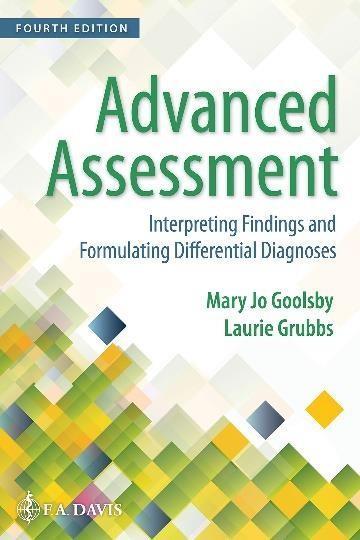Advanced Assessment Interpreting Findings and Formulating Differential Diagnoses



MULTIPLE CHOICE
1. Which type of clinical decision making is most reliable?
A. Analytical I
B. Augenblink
C. Experiential
D. Intuitive
ANS: A
Croskerry (2009) describes two major types of clinical diagnostic decision making: intuitive and analytical. Intuitive decision making (similar to Augenblink decision making) is based on the experience and intuition of the clinician and is less reliable and paired with fairly common errors. In contrast, analytical decision making is based on careful consideration and has greater reliabilitywith rare errors.
PTS: 1 2. You are using the PQRST approach while completing the history of present illness for a patient complaining of pain. Which ofthe following questions is relevant to the “P” portion of this approach?
A. How would you describe your pain?
B. Can you point to the area of most severe pain?
C. How has your pain changed since you first noticed it?
D. What makes the pain worse or better?
ANS: D
In the PQRST model, “P” refers to exploring precipitating and palliative factors. Identifyfactors that make the symptom worse and/or better, any previous self-treatment or prescribed treatment, and response.
PTS: 1
Download All Chapters Here:
https://nursingrade.com/product/advanced-assessment-interpretingfindings-and-formulating-differential-diagnoses-4th-edition-goolsbytest-bank/
3. Essential parts ofa health historyinclude all ofthe following except:
A. Chiefcomplaint
B. Current vital signs
C. Historyof the present illness
D. Review of systems
ANS: B
Vitalsigns are part ofthe physical examination portion ofpatient assessment, not part ofthe health history.
PTS: 1
4. While reading an article on hypothyroidism, you find a helpful graphic depiction of the decisionmaking process recommended bythe authors to find a definitive diagnosis. This graphic is an example of:
A. A clinical prediction tool
B. Clinicalguidelines
C. Adecision tree
D. A diagnostic finding guide
ANS: C
Clinical decision trees provide a graphic depiction of the decision-making process, showing the pathway based on findings at various steps in the process.
PTS: 1
5. Which ofthe following is the least reliable source of information for diagnostic statistics?
A. Evidence-based investigations
B. Primaryreports of research
C. Estimation based on a provider’s experience
D. Published meta-analyses
ANS: C
Sources for diagnostic statistics include textbooks, primary reports of research, and published metaanalyses. Another source of statistics, the one that has been most widely used and available for application to the reasoning process, is the estimation based on a provider’s experience, although these are rarely accurate. Over the past decade, the availability of evidence on which to base clinical reasoning is improving, and there is an increasing expectation that clinical reasoning be based on scientific evidence. Evidence-based statistics are also increasingly being used to develop resources to facilitate clinical decision making.
PTS: 1
https://nursingrade.com/product/advanced-assessment-interpretingfindings-and-formulating-differential-diagnoses-4th-edition-goolsbytest-bank/
6. Which ofthe following can be used to assist in sound clinical decision making?
A. An algorithm published in a peer-reviewed journal article
B. Clinical practice guidelines
C. Evidence-based research
D. All of the above
ANS: D
To assist in clinical decision making, a number of evidence-based resources have been developed to assist the clinician. Resources, such as algorithms and clinical practice guidelines, assist in clinical reasoning when properly applied.
PTS: 1
7. If a diagnostic studyhas high sensitivity, this indicates:
A. A high percentage of persons with the given condition will have an abnormal result
B. A high percentage of persons without the condition will have inconclusive results
C. A low likelihood of normal result in persons without a given condition
D. A low percentage of persons with the given condition will have an abnormal result
ANS: A
The sensitivity of a diagnostic study is the percentage of individuals with the target condition who show an abnormal, or positive, result. A high sensitivityindicates that a greater percentage of persons with the given condition will have an abnormal result.
PTS: 1
8. If a diagnostic studyhas high specificity, this indicates:
A. A low percentage of healthy individuals will show a normal result
B. A high percentage of healthyindividuals will show a normal result
C. A high percentage of individuals with a disorder will show a normal result
D. A low percentage of individuals with a disorder will show an abnormal result
ANS: B
The specificity of a diagnostic study is the percentage of normal, healthy individuals who have a normal result. The greater the specificity, the greater the percentage of individuals who will have negative, or normal, results if they do not have the target condition.
PTS: 1
9. A likelihood ratio above 1 indicates that a diagnostic test showing a:
A. Positive result is stronglyassociated with the disease
B. Negative result is stronglyassociated with absence ofthe disease
C. Positive result is weaklyassociated with the disease
D. Negative result is weaklyassociated with absence ofthe disease
ANS: A
The likelihood ratio is the probability that a positive test result will be associated with a person who has the target condition and a negative result will be associated with a healthy person. A likelihood ratio above 1 indicates that a positive result is associated with the disease; a likelihood ratio less than 1 indicates that a negative result is associated with an absence of the disease.
PTS: 1 10. Which of the following clinical reasoning tools is defined as an evidence-based resource based on mathematical modeling to express the likelihood of a condition in select situations, settings, and/or patients?
A. Clinicalpractice guideline
B. Clinical decision rule
C. Clinicalalgorithm
D. Clinicalrecommendation
ANS: B
Clinical decision (or prediction) rules provide another support for clinical reasoning. Clinical decision rules are evidence-based resources that provide probabilistic statements regarding the likelihood that a condition exists if certain variables are met with regard to the prognosis of patients with specific findings. Decision rules use mathematical models and are specific to certain situations, settings, and/or patient characteristics.
PTS: 1
Chapter 2. Genomic Assessment: Interpreting Findings andFormulating Differential Diagnosis
MULTIPLE CHOICE 1. The first step in the genomic assessment of a patient is obtaining information regarding:
A. Familyhistory
B. Environmental exposures
C. Lifestyle and behaviors
D. Current medications
ANS: A
Download All Chapters Here:
https://nursingrade.com/product/advanced-assessment-interpretingfindings-and-formulating-differential-diagnoses-4th-edition-goolsbytest-bank/